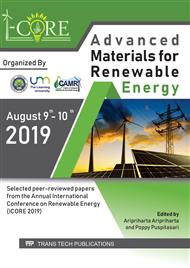p.149
p.156
p.164
p.172
p.184
p.197
p.205
p.212
p.220
Synthesis of CaO@CoFe2O4 Nanoparticles and its Application as a Catalyst for Biodiesel Production from Used Cooking Oil
Abstract:
Until now, used cooking oil (jelantah) has not been utilized optimally. This study seeks to convert this waste into biodiesel. Used cooking oil usually contains high concentration of free fatty acids which can be converted into methyl esters through trans-esterification by methanol. This effort is in line with the increasing need for renewable energy sources. Because the waste still contains high concentrations of free fatty acids, it is necessary to think about the right process and catalyst in converting it as biodiesel. One heterogeneous catalyst that is thought to excel in biodiesel production is ferrite-based nanocomposites, namely CaO@CoFe2O4 nanoparticles. The advantages of this catalyst are: it has high reactivity, thermal and chemical stability, and can be drawn by magnetic fields. This last property facilitates the catalyst isolation at the end of the process for recycling purposes. The catalytic power is expected to increase through impregnation with alkaline earth metal oxides which have a relatively high basicity, namely CaO. The purpose of this study was to synthesize and to characterize CaO@CoFe2O4, then to study its potential catalytic in biodiesel production from used cooking oil in various weight percent of catalyst. The main steps include: (1) synthesis of CoFe2O4 by coprecipitation; (2) Impregnation of CaO into CoFe2O4 and converted to CaO@CoFe2O4; (3) Characterization of the synthesized material by XRD, BET, and SEM/EDX; (4) application of CaO@CoFe2O4 in biodiesel production from used cooking oil; (5) characterization of biodiesel produced by viscosity measurement, yield and GC-MS analysis results. Based on the results of XRD and SEM/EDX analysis, the CaO@ CoFe2O4 catalyst has been successfully synthesized. Under optimal conditions, the yield of methyl ester produced with the addition of 2% of catalyst was 80.62%.
Info:
Periodical:
Pages:
184-193
Citation:
Online since:
July 2020
Keywords:
Price:
Сopyright:
© 2020 Trans Tech Publications Ltd. All Rights Reserved
Share:
Citation:



